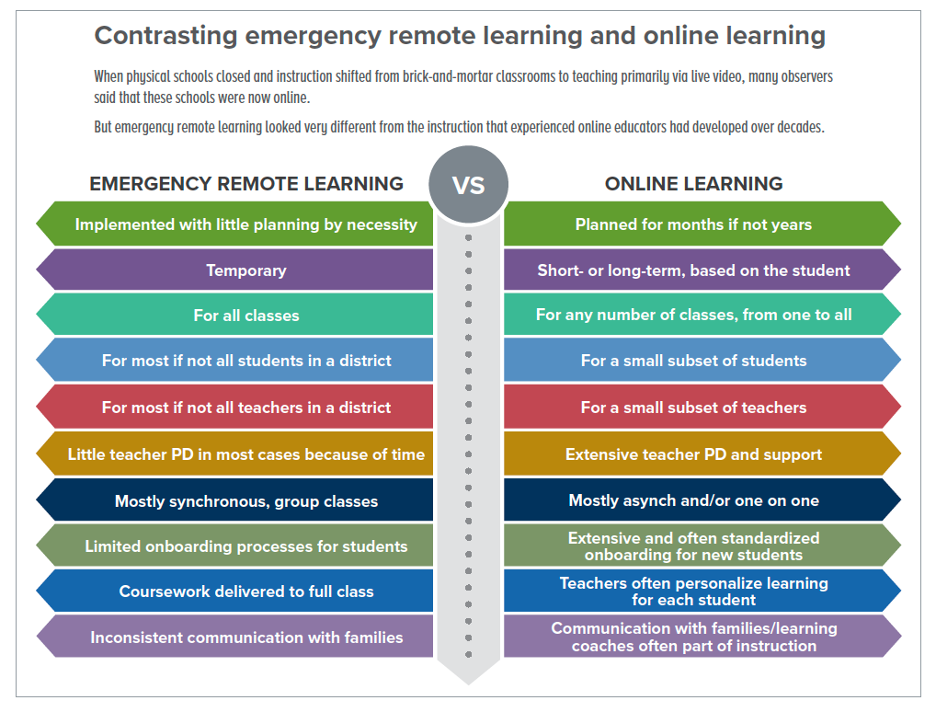Proof Points: Demonstrating positive impact on student outcomes
During the pandemic, the large majority of schools in the United States shifted to emergency remote learning for some amount of time, with the total remote learning time varying by district and region. It was clear at the time that many of those efforts were well-intentioned, and represented the best that could be done on the short notice that COVID provided. It was also clear then, and is being documented now, that many students had poor experiences with remote learning.
But emergency remote learning was different than online and hybrid learning, as we documented in the 2022 Snapshot and elsewhere. Given that our blog readership is mostly aware of these contrasts, I won’t repeat them here other than to include a graphic from the Snapshot below.
Many observers, however, have conflated emergency remote learning with online/hybrid learning, and continue to do so. Some of these observers include people in influential positions, such as writers, policymakers, and state political leaders. Some of these people have asked to see the examples of successful online and hybrid schools—which led us to create the Proof Points Project, in conjunction with Future of School. The project aims to document and showcase examples of positive student outcomes based on externally validated data such as state assessments, graduation rates, SAT/ACT scores, and similar metrics.
We have been receiving and reviewing the first data submissions, and we are thrilled to be documenting the outcomes we were seeking. Although we are still putting the final pieces together before publishing the first profiles (coming in the fall), we have seen enough to know that we will have strong results to show. Some of these examples include:
1) An online school in Texas tracked and compared its students’ scores to the state average on the State of Texas Assessments of Academic Readiness (STAAR®) end-of-course exams in five subject areas. The online students significantly outperformed traditional students statewide in all five subjects on the test.
2) An online school in the Midwest measured its students’ proficiency on state assessments in ELA, math, and science in grades 3-8 and 10-11. The online students outperformed the state average in all subject areas in 2020-21.. Testing was not conducted for the 2019-20 SY due to the pandemic.
3) In another Midwestern state, an online school found its percent of students proficient in all subject areas on its state assessments was 53%, compared to a statewide average of 37%, for the 2020-21 SY. The gap was even larger for the 2018-19 SY at 61% for the fully online students as compared to the state proficiency of 42%. Testing was not conducted for the 2019-20 SY due to the pandemic.
4) Three online schools in three different states shared data that documented significant gains in graduation rate percentages over the past two or three years of data, ultimately surpassing their state graduation rates. One school saw its graduation rate improve from below the state average (52% compared to the state average of 85% for the 2018-19 SY) to surpassing the state grad rate for the 2020-21 SY (90% to the state rate of 84%).
This is just the start. We have supplemental online course providers (mostly state virtual schools) that have comparative data on Advanced Placement scores, and hybrid schools demonstrating very strong outcomes across the board.
Do these data show that online and hybrid learning are a magic bullet that always produce great outcomes? Of course not. Online, hybrid, and blended teaching and learning are instructional modalities that can be implemented well or poorly—and the quality of the teacher matters more than any other single factor. In this way, they are no different than traditional physical schools.
We have reopened the submission process for a limited time (August 12) to continue gathering data-driven examples of effective online and hybrid learning. Visit the Proof Points Projects page on the DLC website to submit your own stories of success and the supporting data.


